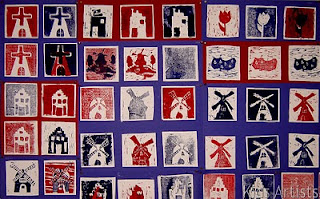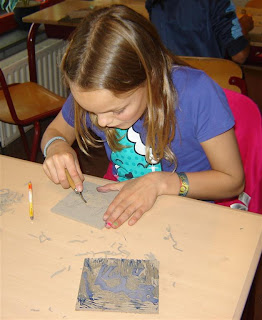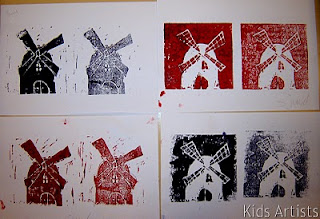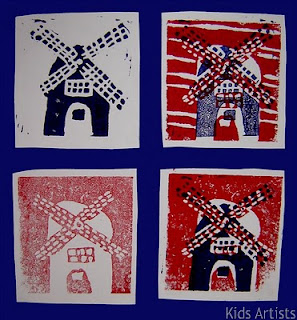
Made by students of grade 6
You need:
- two pieces of linoleum of 12 by 12 cm
- white drawing paper
- lino knives
- block printing ink in red and blue
- flat piece of glass
- linoleum roller
- lino press
- cardboard in red and blue
- scissors
- glue
What are typical Dutch things? Make a word web with the children. Think about cheese, canal houses, tulips, wooden shoes, cows etc.
The children create a drawing on a scrap of paper with the theme I love Holland. Not too many details, because the drawing will be printed. The drawing has to be copied on both pieces of linoleum. It doesn't matter if they don't match exactly; this is even fun while making a two colour print, because the drawing seems to shift a bit.
Use different linoleum knives. Cut the drawing from the first piece of linoleum. Cut the background from the second piece of linoleum, leaving the object. Lines within the object should be cut too.

Shake the bottle of blockprint carefully to be sure oil will mix with the rest. Drip some red paint on the glass and roll it out with the lino roller. Make 2 prints of your work on a white sheet. Rinse the linoleum clean and make 2 prints in blue in the same way.
Repeat this process with the second piece of linoleum: 2 prints in red and 2 in blue. There will be 8 prints if you're finished.

2 pieces of linoleum, 2 colours, 8 prints
Finally use one or more of those prints to make a two colour print. This has to be done by inking piece 1 red and printing it on a blue print of piece 2. See picture below.
Let students choose their best prints and let them decide how many prints they want to use for their final artwork. Cut the prints with 1 cm white aound them. Make a composition on blue or red cardboard and paste the prints with 1 cm between them.

Final composition I love Holland, by Malou, grade 6












.jpg)
.jpg)
.jpg)
.jpg)
.jpg)
.jpg)
.jpg)
.jpg)
.jpg)
.jpg)
.jpg)
.jpg)
.jpg)
.jpg)
.jpg)
.jpg)
.jpg)
.jpg)
.jpg)
.jpg)

.jpg)
.jpg)
.jpg)
.jpg)
.jpg)
.jpg)
.jpg)
.jpg)

